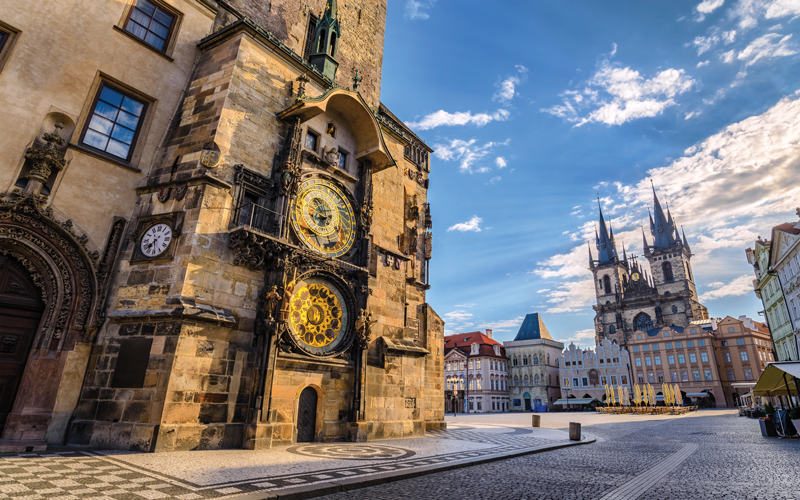Prague: A City for All Shoulder Seasons
The question is not if one should visit Prague,

but rather when. This Central European city has re-invented itself more than once. In its present state, it brims with energy. It is often dubbed as “The golden city of one hundred spires,” the most notable of which are the twin steeples of the Church of Our Lady. Known as a medieval city, it is circled by neighborhoods, each with its own character. Easy public transportation glides visitors into town on rustic barges along the Vlatva River, lifeline of the city, to trams leading to the Charles Bridge for panoramic sunsets and memorable walks for visitors and citizens alike.
There is a reason this city’s youthful energy is up front and center and palpable. For one thing, it has attracted an influx of young people from all over the world (about half a million are expats).Many have settled down to jobs after climbing through the tangle of documentation necessary to plant their dreams and backpacks. Prague is bent on recapturing the vitality that had been under wraps during the Cold War period. But that was then and this is now. As it emerges out of its shell, don’t be fooled if you see the name of the country spelled Czechia (Česko), a brand name now being used for domestic matters, but internationally, it is still Czech or Czech Republic to the rest of the world.
Planning a stay
Often cast as a supporting actor in a number of multi-country or multi-city itineraries, there is enough here to capture hearts and attention and give it a starring role. Among those tours which it appears is the Golden Triangle where it joins Budapest [Hungary] and Vienna [Austria] – eminently doable in 10 days; or for a more intense ride, toss Prague in with other Central European hot cities: Berlin, Vienna, Budapest, Bratislava. The latter might be a bit daunting but is often sold as a doable combo and if the transportation in between is well planned can work.
Add this to that: see Prague solo, don’t be afraid to recommend this city on its own. Call it an old-fashioned city-break, stay-put or city-stay vacation. The time not spent hopping from city to city, train to train or hotel to hotel will keep the frenzy out of the equation and aren’t vacations supposed to be a time to unwind?
Suggest they board smooth and silent trams, tour the city by foot on a Sunday, as well as a midweek evening, rub shoulders with the locals; wander; get lost. And not in summer… because Prague is crushingly popular, mark the travel calendar: March–April to early May and September–October and edge toward November and be in time for the Christmas markets.
The latest addition to Prague’s hotel inventory is the Hotel Andaz Prague, housed in the iconic Sugar palace in the historic center of town.
Must-See Sights
Make the visit compact and focused: St. Vitus Cathedral is likely the most famous and dominant feature of Prague Castle. The decorated interior created by medieval masters is lit to perfection by the rays of sunlight that stream through the stained-glass windows including the windows by Czech Art Nouveau artist Alfons Mucha.
Adjacent to the Castle is the small neighborhood of Nový Svět. Once neglected, local residents gilded their homes and adding monickers such as: Golden Pheasant, the Golden Grape, or the Golden Pea and the Golden Lane and visit a cluster of colorful miniature houses once inhabited by alchemists working for Emperor Rudolf II, who longed to discover the legendary Elixir of Youth and the Philosopher’s Stone. Stop at house No. 22 where world-famous Prague writer Franz Kafka worked.
Visit the Romanesque Basilica of St. George, the Gothic Royal Palace, the extensive Baroque courtyard, the Renaissance Summer Palace of Queen Anne as well as the ultramodern greenhouse in the Royal Gardens.
Beer lovers may be interested in the Pilsner Urquell interactive beer center at Wenceslas Square dedicated to the history of Pilsner beer: features include a beer hall, a beer tapping school, a tasting bar, a restaurant, and a shop. Pilsner Urquell already has a visitor center and museum in Plzeň, which offers tours of the brewery.
If FIT clients are ready to take to the road, they can drive along the Vlatva River, the longest in the Czech Republic. Such an itinerary might look like this: visits to castles, riverside towns, among them are: Český Krumlov (88 miles), České Budějovice (76 miles; climb the 16th century Black Tower for a panoramic view of the town and its castles), Hluboká Castle (89 miles, the castle was modeled after England’s Windsor Castle), Mělník (30 miles away; Chateau Mělník, was home Czech royalty paired with visiting its 14th century wine cellars), and Prague, a hive of history.
To emphasize how important rivers have been to Czech, UNESCO recently declared the craft of “timber rafting” be placed on the intangible cultural heritage list. The tradition and culture associated with timber rafting – such as the verbal art, boating songs and slang – have been preserved as these elements have been passed on to younger generations although commercial river transport has disappeared
Of the distinction, Jan Herget, Director of the Czech Tourism Authority – CzechTourism commented, “Besides timber rafting, the handmade production of beaded Christmas decorations, blueprint production, puppetry, falconry, rides of the kings in Slovácko, carnival routes and masks in Hlinecko, and Slovácko´s verbuňk have been designated similarly with UNESCO.”
As Americans we tend to expect everyone to smile back at us; this is not a Czech reaction and it does not mean they are unfriendly but reserved. Polite, courteous but not American-like, so step back, Czechs are pragmatic and reasonable and calm.




